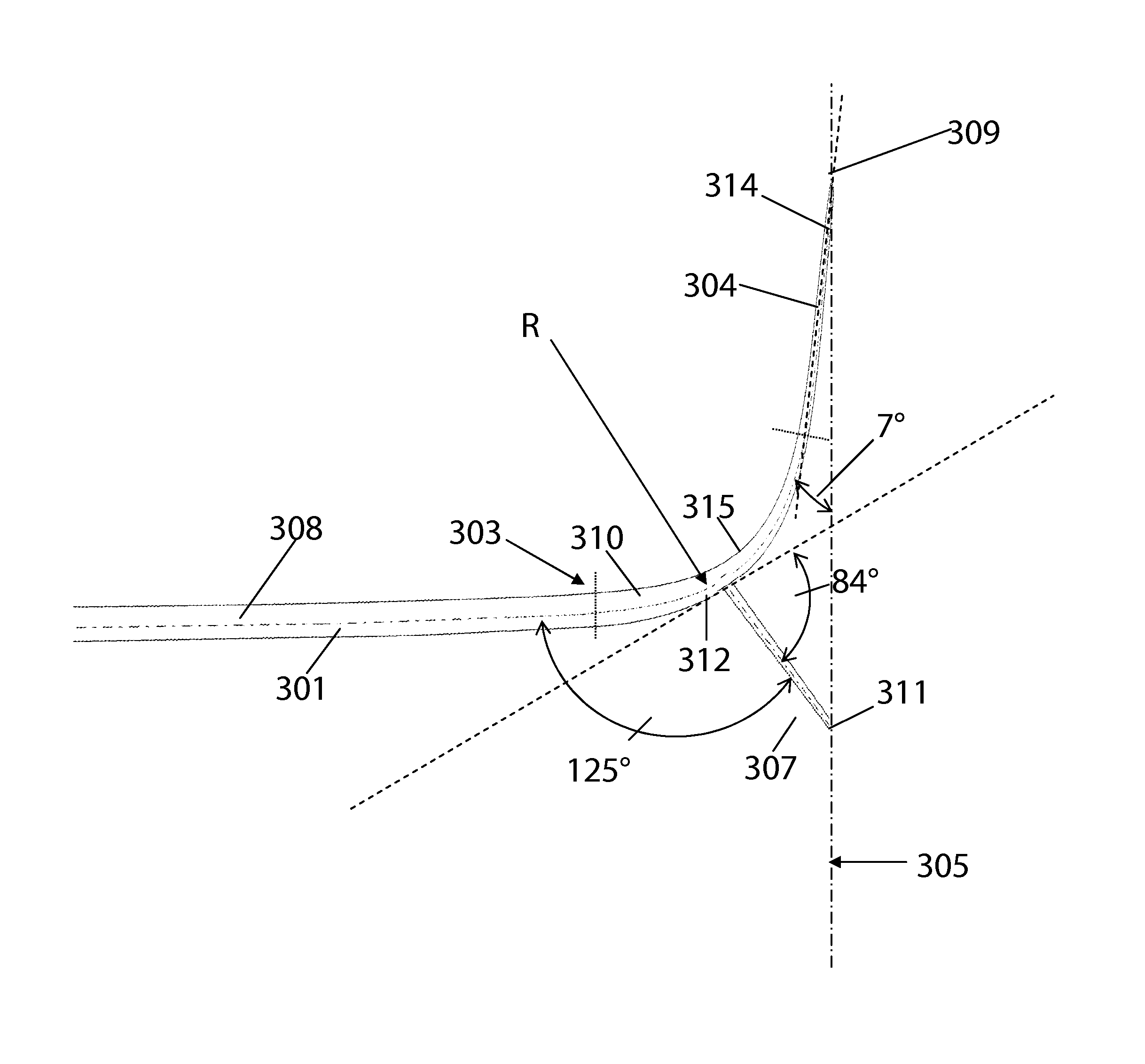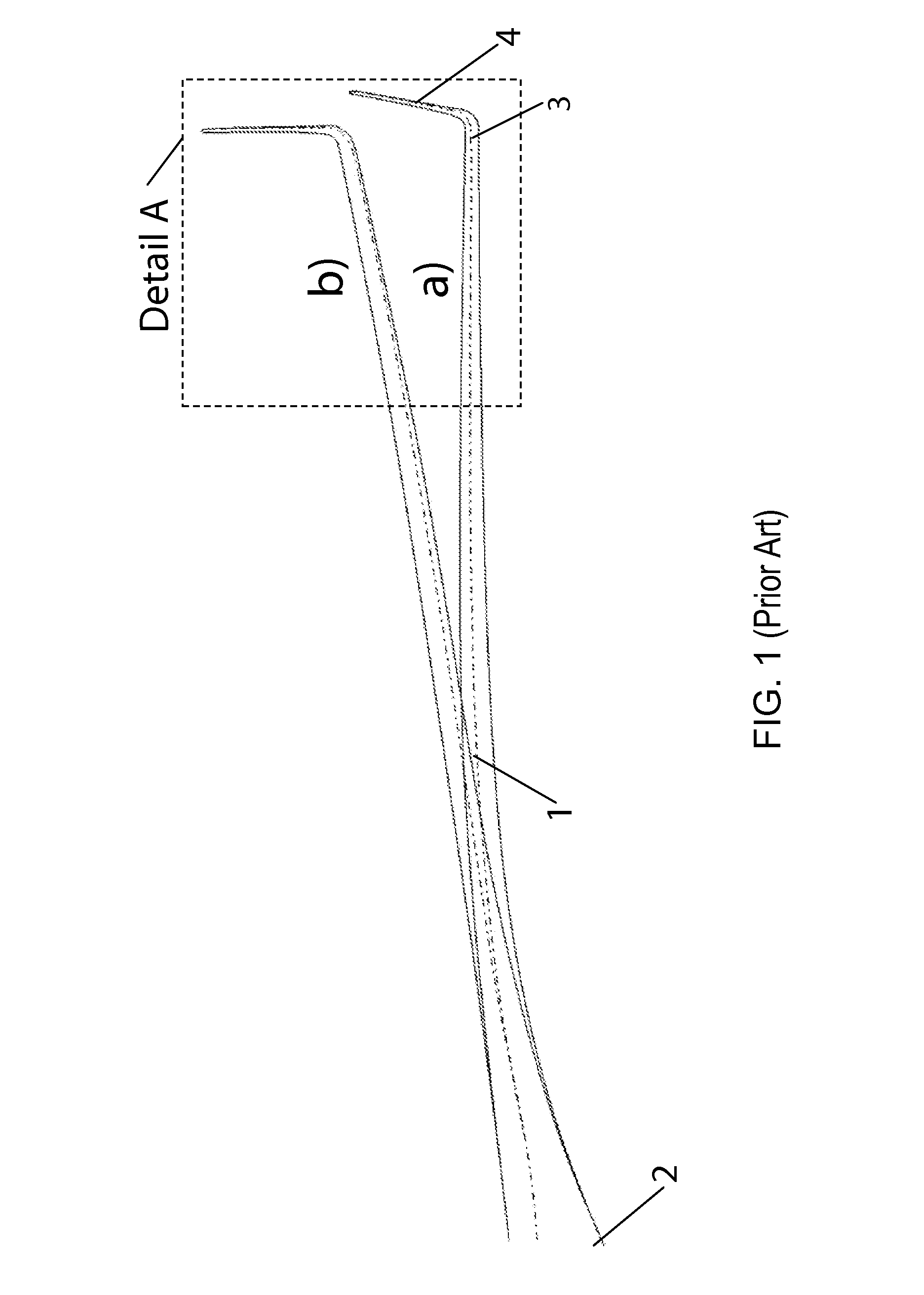Wing tip device
a technology of wing tip and wing tip, which is applied in the direction of airflow influencers, applications, manufacturing tools, etc., can solve the problems of reducing the wing span of the resulting flight shape, affecting the performance of the approach, and no longer being optimal, so as to reduce the interference drag effect, increase the local dihedral curvature, and maintain the constant radius of curvature
- Summary
- Abstract
- Description
- Claims
- Application Information
AI Technical Summary
Benefits of technology
Problems solved by technology
Method used
Image
Examples
first embodiment
[0058]FIG. 3 illustrates an aircraft wing 101 having a planar upper winglet 104 and a planar lower winglet 107. The upper winglet 104 is fixed to the outboard end 103 of the wing 101. The wing 101 defines a wing plane 108. The upper winglet 104 projects upwardly with respect to the wing plane 108. The upper winglet 104 has a tip 109 and a root 110. The lower winglet has a tip 111 and a root 112. The lower winglet root chord 112 intersects with the upper winglet 104 and the lower winglet 107 projects downwardly from this intersection. The upper and lower winglets 104, 107 each have a leading edge and a trailing edge and the trailing edges are adjacent at the intersection. FIG. 3a) illustrates the wing 101 in its ground shape where the tip 109 of the upper winglet 104 and the tip 111 of the lower winglet 107 are coincident at the span limit 105. FIG. 3b) illustrates the wing 101 in its deformed flight shape and shows how a potential loss in span 106 due to the upper winglet 104 is mi...
second embodiment
[0061]FIG. 7 illustrates an aircraft wing 201 having a planar upper winglet 204 and a non planar lower winglet 207. The wing 201 defines a wing plane 208 and the upper winglet 204 projects upwardly with respect to the wing plane 208. The upper winglet 204 is fixed to the outboard end 203 of the wing 201. The lower winglet 207 has a root chord 212 which intersects with the upper winglet 204. The lower winglet 207 projects downwardly from the intersection. The upper winglet 204 has a tip 209 and a root 210. The lower winglet 207 has a tip 211 that is coincident in the spanwise direction with the tip 209 at the span limit 205. The upper and lower winglets 204, 207 each have a leading edge and a trailing edge and the trailing edges are adjacent at the intersection. The wing 201 is illustrated in FIG. 7 in its ground shape where the span limit 205 is enforced.
[0062]The lower winglet 207 has increasing curvature of local anhedral from root 212 to tip 211. The lower winglet 207 may have a...
third embodiment
[0064]FIG. 8 illustrates an aircraft wing 301 having a blended upper winglet 304 and a planar lower winglet 307. The wing 301 has an outboard end 303 to which is fixed the blended upper winglet 304. The upper winglet 304 has a tip 309 and a root 310. The upper winglet 304 is fixed to the outboard end 303 of the wing 301 by its root end 310. The upper winglet 304 has a substantially planar portion 314 and an arcuate transition portion 315. The transition portion 315 is adapted to smoothly blend the outboard end 303 of the wing 301 into the substantially planar portion 314. The arcuate transition portion 315 has a substantially constant radius of curvature R.
[0065]The lower winglet 307 is fixed to the lower surface of the transition portion 315 of the upper winglet 304. The lower winglet has a tip 311 and a root 312. The root chord of the lower winglet 307 intersects with the upper winglet 304 and the lower winglet projects downwardly from the intersection. The upper and lower wingle...
PUM
| Property | Measurement | Unit |
|---|---|---|
| included angle | aaaaa | aaaaa |
| included angle | aaaaa | aaaaa |
| included angle | aaaaa | aaaaa |
Abstract
Description
Claims
Application Information
 Login to View More
Login to View More - R&D
- Intellectual Property
- Life Sciences
- Materials
- Tech Scout
- Unparalleled Data Quality
- Higher Quality Content
- 60% Fewer Hallucinations
Browse by: Latest US Patents, China's latest patents, Technical Efficacy Thesaurus, Application Domain, Technology Topic, Popular Technical Reports.
© 2025 PatSnap. All rights reserved.Legal|Privacy policy|Modern Slavery Act Transparency Statement|Sitemap|About US| Contact US: help@patsnap.com



